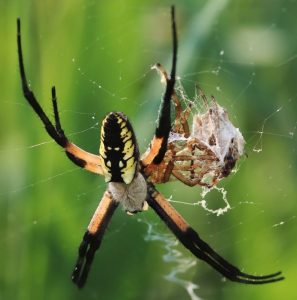Argiope are epic spiders — they’re big, spectacularly colorful, voracious, and if you witness them, you’d be impressed at how quickly they can trap and kill their prey. But now we learn they also use sex appeal to capture dinner.
Predators and prey have direct interactions that influence their short-term behaviors, including resource allocation and strategies for moving through habitats. However, the presently observed behaviors are the products of coevolutionary interactions, posited to be a history of measures and countermeasures between the predator and prey. We found that Argiope (orb-weaver) spiders in the continental USA appear to use a pheromone lure that mimics the mating pheromone of the day-flying Hemileuca moth (buck moth) to entice male moths into their webs. We found evidence that different phylogenetic groups of Hemileuca moths respond to the Argiope pheromone lure with a broad range of responses, ranging from indifferent to acutely strongly attracted, suggesting a coevolutionary history of predator–prey countermeasures. One of these countermeasures may be the potential evolution of moth developmental timing (adult emergence) to avoid Argiope predation in areas where the ranges of the moths and spiders overlap.
I’ve seen fields filled with tens of thousands of Argiope, with a web every few steps. Oddly, I didn’t see any moths nearby, even though this should have been a giant invitation to an orgy. No moths, period. I wonder why?



Still not as funny as watching orchid bees with orchids.
The very definition of beer-goggling.
https://www.britannica.com/science/mimicry/The-evolution-of-mimicry
https://www.southcoastorchidsociety.com/orchidnotes_2021_04.html
I like the silhouette of Marge Simpson standing with her arms akimbo on its back. She looks like she’s about to roast Homer for coming home drunk again.
I always look for mosquitos in webs and smile when I see any, then thank the spider for doing a great job.
Wait, do moths have periods?
I mean planets do – orbital ones – but moths?
These spiders were one of the more impressive parts of Texas.